
BEECHER BIBLE AND RIFLE CHURCH
 Until 1854, when Kansas was opened for settlement, the spot on which this old landmark church stands was just part of a vast ocean of tall prairie grass, under the ever-changing skies. To the north lay the Kaw River, crowding the bluffs beyond. A few miles to the east stood hills of spectacular beauty, and the prairie rolled gently away toward the south and west. The silence was broken only by the winds or by the song of a meadowlark, and at night by the music of the prairie wolves. The land belonged to the Indians, to the roving herds of buffalo and antelope, and to the great flocks of migratory birds.
Until 1854, when Kansas was opened for settlement, the spot on which this old landmark church stands was just part of a vast ocean of tall prairie grass, under the ever-changing skies. To the north lay the Kaw River, crowding the bluffs beyond. A few miles to the east stood hills of spectacular beauty, and the prairie rolled gently away toward the south and west. The silence was broken only by the winds or by the song of a meadowlark, and at night by the music of the prairie wolves. The land belonged to the Indians, to the roving herds of buffalo and antelope, and to the great flocks of migratory birds.
The Kansas-Nebraska Bill, passed in May, 1854, changed all this forever. It provided that Kansas could become a free state or a slave state, depending on how the people of Kansas voted. The race was on to stake out claims, and to vote Kansas “free,” or “slave.”
Two years later, in 1856, there were already about sixty people living within a few miles of this place that they called Wabaunsee, an Indian name meaning “Dawn of Day.” Here, on the south bank of the Kaw River, 100 miles west of Kansas City, a settler had built a tiny store.
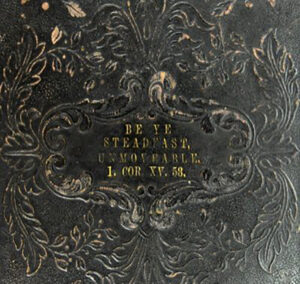 In New England, “Kansas Fever” ran high. The people of New Haven, Connecticut, raised money to send a group of colonists to Kansas; fifty-seven men, four women, and two children. Led by one of New Haven’s most respected citizens, Charles B. Lines, these were well-educated men, many with professional training. They left good jobs and good homes behind them. They were not just adventurers, with little to lose by going west; they were men making a sacrifice for their ideals.
In New England, “Kansas Fever” ran high. The people of New Haven, Connecticut, raised money to send a group of colonists to Kansas; fifty-seven men, four women, and two children. Led by one of New Haven’s most respected citizens, Charles B. Lines, these were well-educated men, many with professional training. They left good jobs and good homes behind them. They were not just adventurers, with little to lose by going west; they were men making a sacrifice for their ideals.
Before the Connecticut-Kansas Company left for Kansas, a meeting was held in North Church, in New Haven. Professor Silliman, of Yale, pledged $25.00 for a Sharps rifle for the Company. Then Henry Ward Beecher, the great minister from Brooklyn, NY, pledged that his congregation would give the money for twenty-five rifles if the audience would give another twenty-five; people in the crowd responded in great excitement, and soon twenty-seven had been promised. A few days later
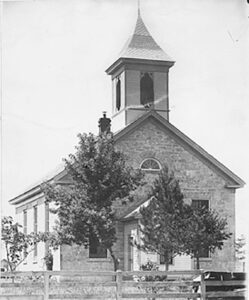 Mr. Beecher sent Mr. Lines $625 for the rifles, and with the money came twenty-five Bibles, the gift of a parishioner.
Mr. Beecher sent Mr. Lines $625 for the rifles, and with the money came twenty-five Bibles, the gift of a parishioner.
The company left New Haven at midnight, on March 31st, after a torchlight parade across town to the steamboat to New York. The next day they were on a train to St. Louis, a three-day journey of great discomfort. From St. Louis they sailed up the Missouri River on the steamboat Clara, as far as Kansas City. There they bought thirty wagons and sixty oxen, along with farm implements, tents, and provisions for thirty days. They started west on the Oregon Trail, stopping for a few days in the Free-state town of Lawrence, where they were welcomed by Free-state leaders. After visiting Mission Creek, west of present-day Dover, they continued along the trail to Uniontown, near what is now Willard. Here, instead of following the trail across the Kaw River, they veered left and continued west, south of the river, until they reached the place their scouts had selected, Wabaunsee, “The New Haven of the West.”
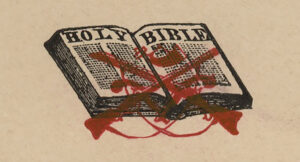 In late April 1856, (almost a month away from New Haven) Wabaunsee suddenly became a busy tent city. Streets were laid out, and city lots and tracts of prairie land were divided among the men of the Company. The settlers already on the scene welcomed the New Englanders, and some of them joined the worship services that were held on Sundays, first in tents, then in cabins or dug-outs. The new settlers found pioneer life very hard. Some became ill or discouraged and returned home.
In late April 1856, (almost a month away from New Haven) Wabaunsee suddenly became a busy tent city. Streets were laid out, and city lots and tracts of prairie land were divided among the men of the Company. The settlers already on the scene welcomed the New Englanders, and some of them joined the worship services that were held on Sundays, first in tents, then in cabins or dug-outs. The new settlers found pioneer life very hard. Some became ill or discouraged and returned home.
Those who remained until August were then called to go to the defense of Lawrence. Organized as “The Prairie Guards,” under their elected captain, William Mitchell, they spent six weeks fighting the border-ruffians.
The winter of 1856-57 was one of suffering in Wabaunsee, but things seemed more hopeful in the spring, when the wives and children came to join the men. Now that a permanent settlement seemed assured, there was a desire for a permanent church organization.
In late June 1857, fifteen of the members of the Colony and thirteen other settlers met to organize “The First Church of Christ in Wabaunsee,” with the Rev. Harvey Jones as Pastor.
Of this group of twenty-eight charter members, nine were women. After two years of raising funds for a church building, mostly in New Haven, they started construction of the sturdy stone church-that still stands in Wabaunsee.
The stones were hauled from nearby quarries, on sleds drawn by oxen. The mortar was mixed by hand, and the long shingles, called “shakes,” were made with crude hand tools. The rows of straight-backed pews were divided down the center of the church by a low wooden partition that separated the men from the women.
From the balcony across the rear of the church, a ladder led to the belfry. The church-yard was edged with hitching posts, and there were newly planted trees and lilacs in appropriate spots.
The new church was dedicated in May, 1862. By that time some of the members had already gone to fight in the Civil War. Soon there were only a few boys and older men to carry on the work in Wabaunsee. But after the war was over the town began to grow again. It never became the great city the people from New Haven had envisioned, but the area grew into a thriving farm community.
The church became one of the largest and most influential Congregation churches in Kansas. Only a few of the Connecticut families remained to bring up their children in Wabaunsee, but those few were a strong influence there, and in Kansas.
The pioneers of Wabaunsee sent their children to Washburn College or to Kansas State Agricultural College, to become teachers, ministers, or missionaries. These young people then went to far places in the world to work, but they never forgot Wabaunsee.
When the church needed repairs they always gave generously to assist the Willing Workers Society, that group of church ladies forever busy with ice cream socials or oyster suppers given to raise money to help pay the minister’s salary or the mortgage payments on the parsonage.
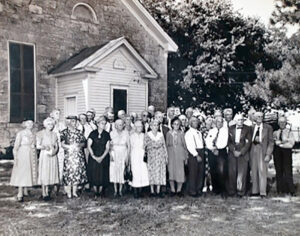 In 1907, old friends of the church came from far away to help celebrate the 50th Anniversary of the First Church of Christ in Wabaunsee. Only two of the original Company still lived in Wabaunsee then, but they both played a large part in the Jubilee celebration.
In 1907, old friends of the church came from far away to help celebrate the 50th Anniversary of the First Church of Christ in Wabaunsee. Only two of the original Company still lived in Wabaunsee then, but they both played a large part in the Jubilee celebration.
In 1913, there was a renewal of interest in the church when a new minister came to start an experiment in rural development. The Rev. Anton Boisen, later to become a very famous man, organized the people to build sidewalks, improve the churchyard and the cemetery, and to better their economic and social lives.
But the population of the area was dwindling, and so many people left, as an indirect effect of World War I, that after 1917 it was no longer possible to keep a resident minister. After that there were guest ministers from time to time, and services held with the Methodist church of Wabaunsee. An effort was made to federate the two churches, but this failed, and soon the old stone church was practically deserted. The last entry in the official record book was made in 1927.
The descendants of the “Beecher Colony” organized “Old Settlers Association” in 1932. The last Sunday of August was designated “Old Settler’s Day by the Association.
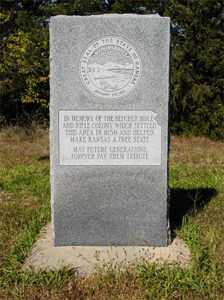 Throughout the years “Old Setters” gathered on this day as well as Decoration Day to reminisce and to honor men and women who had made that church a symbol of freedom around the world.
Throughout the years “Old Setters” gathered on this day as well as Decoration Day to reminisce and to honor men and women who had made that church a symbol of freedom around the world.
Homecoming continues to be celebrated on the last Sunday in August. Former members spent more than one thousand dollars in the renovation of the Church in 1948. This same group, a few years later, raised a similar sum to erect a monument gate for the Wabaunsee Cemetery entrance. The gate was designed by Maude Mitchell, the daughter of William Mitchell. He was the captain of the “Old Prairie Guards.”
In 1950 residents of Wabaunsee formed a new church group, and began to hold weekly services. This was said to be the first inter-racial Congregational Church in Kansas, a fact which impressed many as a fitting tribute to the Connecticut-Kansas Colony.
The Church’s Centennial, in August 1957, saw the old building much as it had looked when completed, almost a hundred years before. The old pews were still uncomfortable, the floors still dark and creaky, and the windows still tall and narrow. But a year later much had been changed.
A youth group, under the sponsorship of the Kansas Pilgrim Fellowship, spent two weeks in Wabaunsee renovating the building with members of the church. They put in a new floor, a tile ceiling, and replaced the old coal stoves with modern heaters. Soon after that, the parishioners of a church about to be inundated by the waters of Tuttle Creek Reservoir donated its pews to replace the old ones in the Wabaunsee church.
More recently stained-glass inserts have been placed in the old windows. Sunday Worship Service and Sunday School are conducted each Sunday. Continuation of these services dates back to 1950. Since this time these services have been conducted by full time and part time ministers, special guests, and laypersons.
The congregation continues to welcome guests, guest speakers, new and old members. In 1992, The George Thompson Christian Center was built. This building has modern facilities for Sunday School classes and other activities. This church has been servicing the public since 1862, although not continuously.
In the park, a few blocks north of the church stands a monument erected by the Kansas State Historical Society. On it are carved these words:
“In memory of The Beecher Bible And Rifle Colony, Which Settled This Area In 1856 And Helped Make Kansas a Free State. May Future Generations Forever Pay Them Tribute.”
